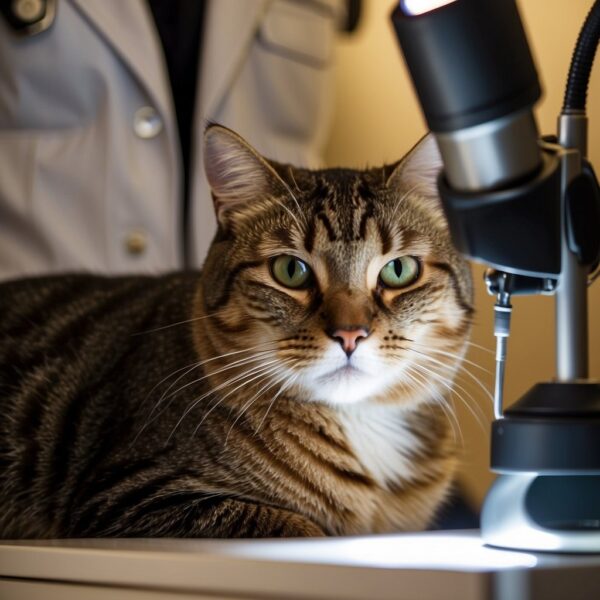
Cat chin acne is a relatively common skin condition in felines that manifests as blackheads, pimples, and sometimes sores on a cat’s chin and lip area. This condition results from the overproduction of keratin, an excess of skin oil, or the accumulation of shed skin cells, often leading to plugged hair follicles. While the presence of black spots on your cat’s chin may initially appear as simple dirt or debris, these blemishes can actually signal the onset of acne.
Although cat chin acne can affect any cat regardless of age or breed, it’s important to recognize that the severity of the condition can vary. In some cats, chin acne may present as a mild, barely-noticeable issue, while in others it may escalate to swollen, painful areas that are prone to secondary infections. Identifying the signs early and adopting appropriate care routines can help manage this skin problem effectively and prevent more serious complications. Proper hygiene, dietary changes, and stress reduction are all part of a holistic approach to treatment, though persistent or severe cases may require veterinary intervention.
Key Takeaways
- Cat chin acne appears as blackheads and can lead to swollen, painful areas if severe.
- Early recognition and proper hygiene are crucial for managing feline chin acne.
- Severe cases of cat chin acne may require consultation with a veterinarian for treatment.
Understanding Cat Chin Acne
Feline chin acne is a skin condition in cats that often presents as blackheads or lesions on the chin and needs a correct diagnosis for proper management.
Definition and Overview
Feline acne is a condition where comedones (blackheads) and possibly pimples appear on a cat’s chin due to the overproduction and entrapment of keratin and sebum in the hair follicles. It is associated with the sebaceous glands, which produce an oily substance that can contribute to the clogging of follicles.
Causes of Chin Acne in Cats
The exact cause of chin acne in cats is not well-understood, but it is thought to occur when there’s excessive production of skin oils, known as sebum, combined with an overproduction of keratin. Factors that might contribute include:
- Poor grooming habits
- Stress
- Compromised immune system
- Dirt accumulation
- Overactivity of sebaceous glands
Symptoms and Identification
Symptoms of feline acne can vary from mild to severe and include:
- Presence of blackheads and dark spots on the chin
- Development of lesions, pimples, or comedones
- Inflammation and swelling of the chin area
- Possible development of secondary bacterial infections
To identify feline acne, a veterinarian may examine skin scrapings under a microscope or culture to rule out other conditions such as mites or fungal infections.
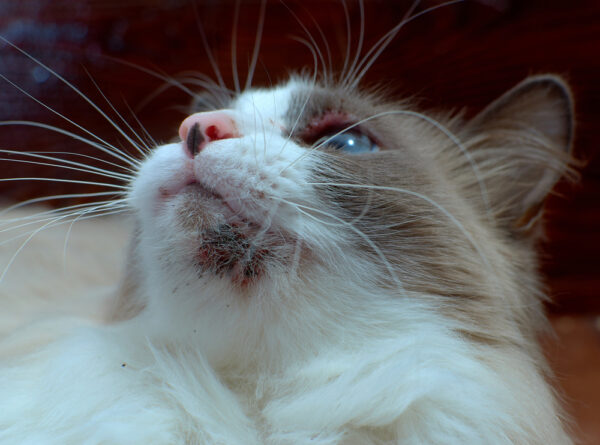
Diagnosis of Cat Chin Acne
A definitive diagnosis of cat chin acne involves a combination of clinical examination and diagnostic tests to rule out other conditions such as mites, fungal infections, or bacterial infections.
Veterinary Examination
A veterinarian will first conduct a thorough physical examination focusing on the chin and lip area. Observation of symptoms like blackheads, inflammation, and swelling helps the veterinarian to assess the severity of the acne. They may also examine the cat’s overall health to determine if there are any underlying conditions contributing to the skin issue.
Skin Scraping and Cytology
Skin scraping is a diagnostic procedure where the veterinarian gently scrapes the skin to collect samples for analysis. This test is crucial for identifying the presence of mites that can cause symptoms similar to acne. Skin cytology, examining skin cells under a microscope, helps detect abnormalities such as excess keratin, bacterial or fungal infections.
Bacterial Culture and Sensitivity
For persistent or severe cases, a bacterial culture is recommended to determine if there is an infection and which bacteria are present. The process involves taking a sample from the affected area and growing the bacteria in a lab. A sensitivity test subsequently helps in selecting the most effective antibiotic for treating the detected bacterial infections.
Cat Chin Acne Treatment Options
Effective management of cat chin acne may require a combination of treatments, including topical applications, oral medications, and modifications to the cat’s environment and care routine. Timely intervention can help prevent the condition from worsening.
Topical Treatments
For mild cases of chin acne in cats, topical treatments are often the first line of defense. They can include:
- Warm Compresses: Applying a warm compress to the affected area can help to soften and remove accumulated debris and crusts.
- Benzoyl Peroxide: Products containing benzoyl peroxide can help to flush out the hair follicles and reduce the formation of comedones.
- Antibiotic Ointment: If a secondary bacterial infection is present, a vet may prescribe a topical antibiotic ointment, such as mupirocin.
- Retinoids: In some instances, topical retinoids may be used to normalize the keratinization process and prevent blockage of the follicles.
Oral Medications
Severe or recurrent cases of acne may necessitate oral medications. These include:
- Oral Antibiotics: Antibiotics such as tetracycline or clindamycin might be prescribed if there’s a notable bacterial infection.
- Anti-Inflammatory Medication: To reduce inflammation and discomfort, a veterinarian may prescribe anti-inflammatory medications, which can also be used as part of the treatment plan for feline acne.
Lifestyle and Environmental Changes
Adjusting a cat’s lifestyle and environment can help mitigate and prevent future outbreaks of chin acne:
- Non-Plastic Food Dishes: Switching to glass, stainless steel, or ceramic food dishes can reduce chin acne, as plastic dishes can harbor bacteria.
- Regular Cleaning: Regularly cleaning the cat’s chin and its food and water dishes can prevent buildup of substances that may contribute to acne formation.
Each cat is unique and so is their response to various treatments; regular consultation with a veterinarian is essential to determine the most suitable course of action.
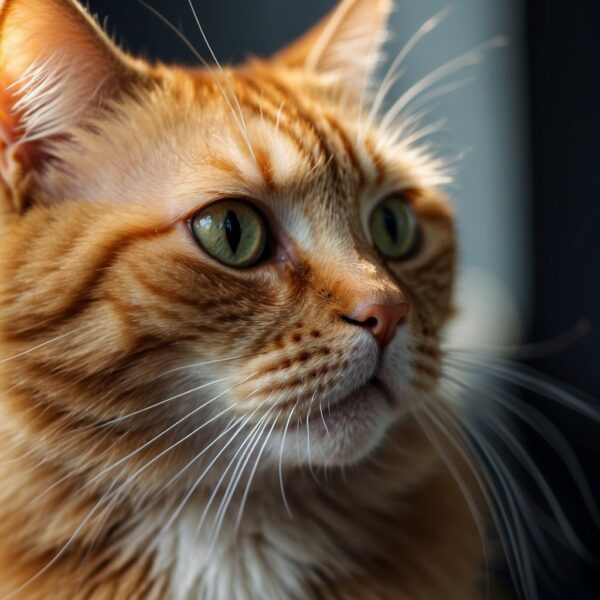
Preventing Recurrence
To minimize the likelihood of cat chin acne recurrence, cat parents should consider adopting better hygiene practices, reviewing dietary elements, and making strategic household changes.
Cleansing and Hygiene
Regular grooming is crucial as poor grooming habits can exacerbate chin acne. A gentle cleanse of the cat’s chin with a warm, damp cloth can help remove debris. Pet parents should ensure any cleansing agents used are specifically formulated for cats to avoid irritation. Improved hygiene may also involve keeping the cat’s living environment clean to reduce exposure to allergens and bacteria.
Dietary Considerations
Cats might develop chin acne due to food allergies. Therefore, it’s important to observe the cat for any signs of allergies and consult a veterinarian for an allergy test if needed. Additionally, pet parents should opt for high-quality cat food that supports skin health.
Household Adjustments
Using non-porous bowls such as stainless steel, ceramic, or glass, instead of plastic, can prevent the buildup of bacteria that might promote acne. Stress can be a contributing factor to chin acne; hence, maintaining a calm and enriching environment can help. Pet parents are advised to replace or thoroughly clean food and water bowls regularly to ensure optimal hygiene.
Possible Complications
While cat chin acne can often be a mild condition, it has the potential to lead to more serious skin issues if left untreated. Complications can range from discomfort and pain to more severe skin infections.
Severity and Pain Management
The severity of a cat’s chin acne can vary, with some cases being a minor nuisance, while others cause considerable discomfort. In severe cases, the affected area can become painful and swollen, necessitating management strategies that include pain relief treatments under the guidance of a veterinarian.
Secondary Infections
A primary concern in cats with chin acne is the risk of secondary infections. When pustules rupture, bacteria can invade and lead to conditions such as folliculitis (inflammation of the hair follicles) or furunculosis (a more severe infection involving the formation of boils). These require prompt veterinary attention to prevent further complications.
Further Dermatological Issues
Untreated cat chin acne may lead to ongoing dermatological problems, including hair loss and chronic skin issues. The repetitive cycle of acne flare-ups can damage the skin’s integrity, making it more susceptible to various forms of dermatitis and potentially causing long-term skin alterations.
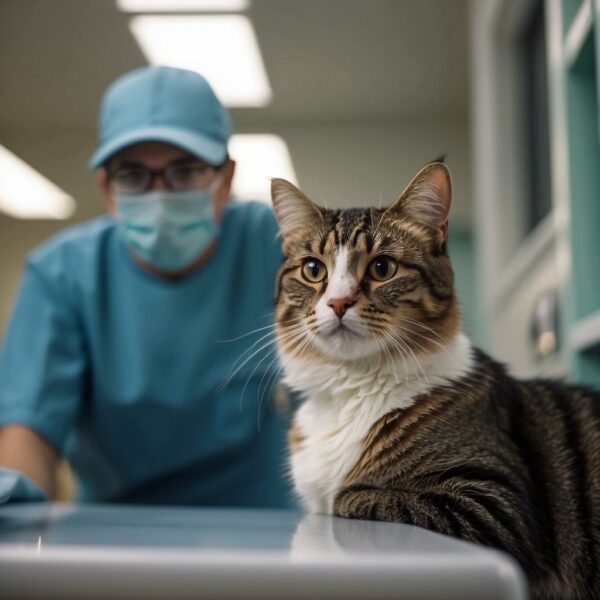
When to Consult a Veterinarian
Cat parents should be aware of when it’s time to seek expert advice for their feline’s chin acne. Observing the initial signs of chin acne, such as the presence of blackheads or minor skin irritation, may not immediately necessitate a veterinary visit. Simple at-home cleaning might resolve these mild symptoms. However, certain situations require a veterinarian’s intervention.
Immediate veterinary consultation is recommended if the cat exhibits any of the following:
- Persistent Symptoms: If the cat’s symptoms persist beyond basic treatments or if the acne reoccurs regularly.
- Severe Acne: The presence of numerous pustules, swelling, or significant inflammation on the cat’s chin.
- Pain or Discomfort: The cat shows signs of pain like avoiding touch, excessive scratching, or agitation.
- Secondary Infections: Signs of infection such as pus, severe redness, or an unusual odor from the affected area.
A veterinarian can provide a thorough examination to determine the cause, offer a proper prognosis, and prescribe medication if necessary. They may also conduct tests to rule out other conditions like mites or fungal infections, which can mimic the symptoms of chin acne.
| Early Signs | Advanced Symptoms | Action Required |
|---|---|---|
| Blackheads | Numerous pustules | Consult a veterinarian |
| Mild redness | Noticeable swelling | Seek professional diagnosis |
| Minor itching | Severe inflammation or infection | Possible medication prescription |
It’s crucial for cat parents to monitor their pets and respond appropriately to changes in health. Early detection coupled with a professional assessment ensures a better prognosis and timely treatment, leading to a quicker and more comfortable recovery for the cat.
Understanding Related Conditions
When investigating chin acne in cats, it is crucial to differentiate it from other skin conditions that may present with similar symptoms. Expert analysis often calls for ruling out various differential diagnoses and understanding the connection with other skin disorders.
Differential Diagnoses
Allergies: Cats may experience allergies that manifest symptoms similar to acne, such as skin irritation and bumps. However, allergies usually cause more generalized skin reactions beyond the chin.
Mange: Caused by mites, mange can mimic the symptoms of feline acne but typically affects larger areas of the skin and is accompanied by hair loss.
Ringworm: This is a fungal infection not related to worms and presents as circular lesions on a cat’s skin, sometimes resembling acne but with distinct rings.
Fleas: While fleas cause itching and irritation, the presence of flea dirt can be confused with blackheads, a common sign of chin acne.
Associated Skin Disorders
Viral Infection: Viral infections can lead to skin lesions; however, they often come with systemic signs such as fever, which is not characteristic of feline acne.
Immunosuppression: Cats with compromised immune systems may present with a variety of skin conditions, making them more susceptible to severe cases of chin acne.
Hormonal Imbalances: While not as directly linked to feline chin acne as in human acne, hormonal changes can affect a cat’s skin health and potentially exacerbate underlying skin disorders.
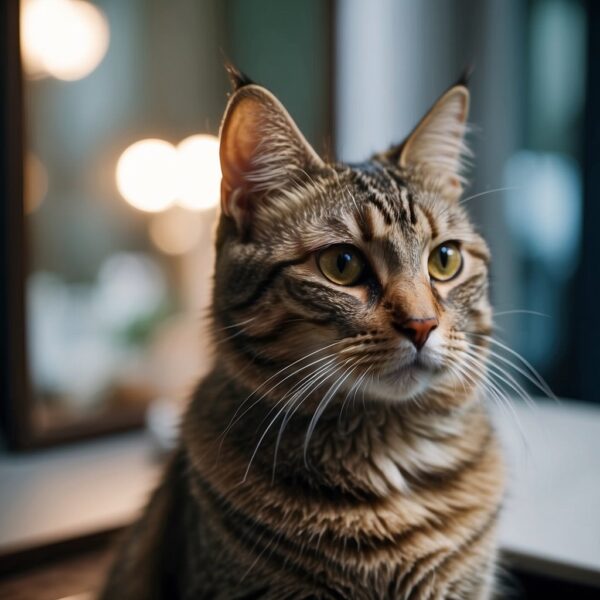
Frequently Asked Questions
This section addresses common inquiries about feline chin acne, providing concise answers to help cat parents understand and manage this condition effectively.
What are the most effective treatments for feline chin acne?
The most effective treatments typically include topical ointments or gels prescribed by a veterinarian, and in some cases, oral medications. Keeping the affected area clean and switching from plastic to metal or ceramic food dishes may also be recommended.
Are there any home remedies for managing cat chin acne?
Home remedies may involve gently cleaning the cat’s chin with a mild antiseptic, but it’s crucial to avoid irritating the skin further. Regularly cleaning food bowls to prevent bacterial growth can help manage mild cases.
How long can feline chin acne typically last?
The duration of feline chin acne varies with each cat and the underlying cause. Some cases resolve quickly with treatment, while others may experience periodic flare-ups or chronic issues.
What are the symptoms indicating that a cat’s chin acne might be causing pain?
Symptoms that suggest pain can include reluctance to being touched near the affected area, excessive scratching or rubbing of the chin, and changes in behavior such as increased aggression or hesitation to eat.
Why do cats develop black deposits under their chin?
Cats develop black deposits, typically called blackheads or comedones, under their chin due to blocked hair follicles. This is often caused by an overproduction of keratin or sebum, which traps dead skin cells and forms blackheads.
Can feline chin acne resolve without intervention?
While mild cases may occasionally resolve without intervention, a veterinarian should evaluate any signs of chin acne to determine appropriate treatment and prevent potential complications.